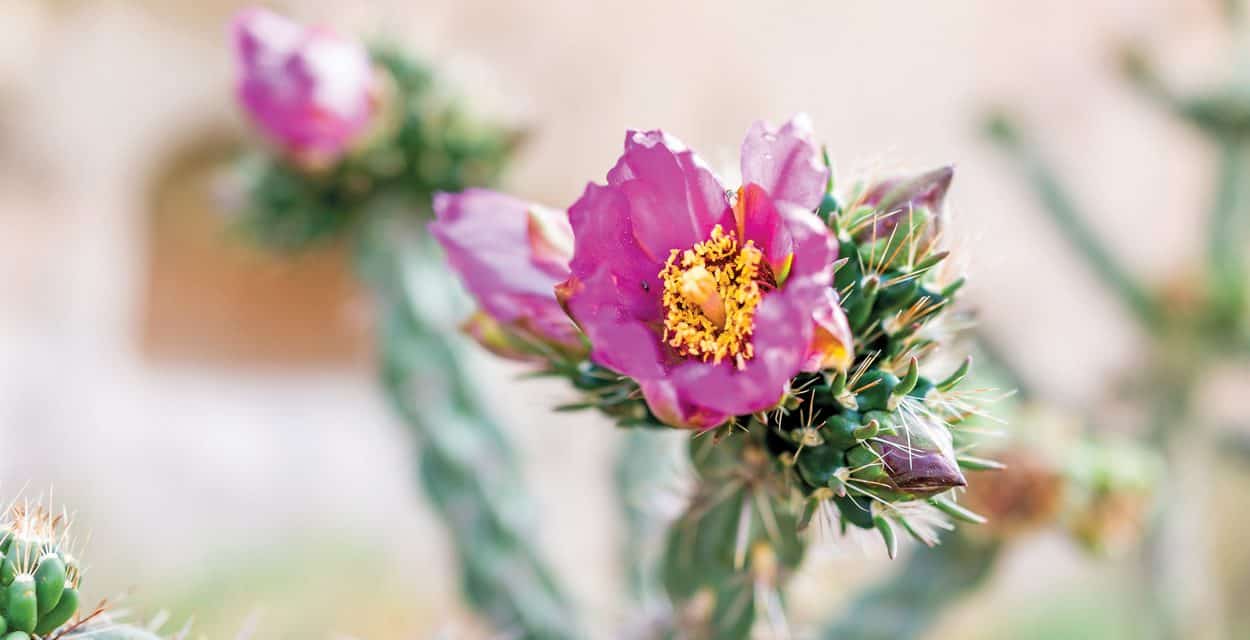Gardening Practices to Save Water and Beat the Heat
By Marisa Thompson

Prickly pear cactus.
Calling all plant fanatics, gardeners of all skill levels, rosarians, arborists, and shrub lovers: If you are responsible for watering even a single plant, this exercise is for you. Let’s take a minute to consider how we are adjusting to the ongoing drought and increasing temperatures. What can we do to maximize water efficiency in our yards and gardens?
My first ideas are to plant smarter, get creative with shade, slow and capture water runoff, and mulch like our lives depend on it.
Planting smarter involves several aspects of gardening. Selecting the best plant for a given spot is a big one. Think about available space in your yard and strategize where to put what. Hot spots are great for heat-loving plants, like prickly pear cactuses, yuccas, agaves, New Mexico privets, and lots of ornamental grasses. Crape myrtles, desert willows, figs, pomegranates, and vitex are other examples of plants that can take intense heat without needing excessive amounts of water. These may not survive at higher elevations, depending on how low winter temperatures drop in your area.
While we desert gardeners are doing much better at picking native and adapted plants that are more suited to our urban climates, there’s always room for improvement. For lists of plants that have lower water requirements and are both cold and heat hardy, reach out to local nurseries and contact your county Cooperative Extension Service office (aces.nmsu.edu/county). Online resources include the Albuquerque Bernalillo County Water Utility Authority (505outside.com) and the Native Plant Society of New Mexico (npsnm.org).
To get creative with shade, we need to change how we think about it. The mental image of deep shade under a huge tree just isn’t practical for new plantings. It takes a long time and a lot of water for a tree to grow big enough to have a full canopy. Are you looking for recommendations for a tree that grows fast, gets really big, and will live a long time? It sounds to me as if you’re describing multiple trees—and a shade structure too! Unfortunately, many of the faster-growing trees aren’t as long lived, taking several years to get large enough to provide enough shade for a small patio. This year, consider installing a shade structure. The options are as plentiful as they are colorful: canopy tents, shade sails, hip and cantilever shade structures, gazebos, and more. Perennial vines like honeysuckle, grapes, silver lace vines, wisteria, and trumpet vines can be trained to grow up over a trellis or pergola quickly and with relatively low amounts of water. Morning glory is an example of an annual vine that can cover a surprising amount of area in a single growing season, even when grown from seed and planted late. The structures don’t have to be permanent. On the south side of my house, I’m using twine strung from the fence top to the eaves as a guide for honeysuckle and trumpet vines to shade the walkway and garage. And they don’t have to be human made either. Take advantage of the shade pockets provided by heat-loving plants. There’s still plenty of sunlight for pickier plants to grow there, but with less heat stress and lower water needs.

Cane cholla cactus.
When it comes to rainfall, notice how water moves across your yard, paying special attention to any water that runs off into the street. The Arid LID Coalition is a collaborative group based in Albuquerque that “promotes arid adapted green stormwater infrastructure (GSI) and low-impact development strategies to capture stormwater as an asset.” Their website (aridlidcoalition.org) is an amazing resource, with links to demonstration project updates and newsletters describing all sorts of clever ways to manage stormwater. Contouring your yard with swales and berms is an effective way to direct water toward specific plants and to slow it down so that more soaks in than runs off. In the Arid LID Coalition booklet titled Middle Rio Grande Low Impact Developments: Projects for Storm Water Management, contouring is described in great detail, and the term “swale” is used sixty-one times. “Swales are depressed sections of land, designed to slow and capture runoff by spreading it horizontally across the landscape, facilitating runoff infiltration into the soil.” Catchment devices, like water barrels and cisterns, are wonderful, but even the larger ones overflow when we’re lucky enough to get a good dose of rain. Swales can be installed to manage cistern overflow or positioned at the base of gutter spouts to move water away from the foundation and over to plants’ roots. Yerba mansa, a native plant that normally grows in riparian areas, thrives in low areas of my contoured yard. During monsoon season, these plants have a swale of a time.
“Monsoon,” however, is a bit of a misnomer. “Monlater” tends to be more accurate, but it’s still preferred to “monnever.” Last year, the total annual rainfall measured at the New Mexico State University Agricultural Science Center at Los Lunas was a scant 5.7 inches; only 10.2 inches were reported in Mora at the John T. Harrington Forestry Research Center. Even if New Mexico weren’t in a drought, “normal” rainfall amounts are also distressing. And the heat doesn’t help. Pan evaporation from 1923 to 2005 in Los Lunas was more than 73 inches per year, on average. Evaporation rates have gotten higher in recent years and are only expected to continue in that direction. And at the same time that our plants are practically screaming for more water, many municipalities are pleading with residential customers to cut back on landscape water use.
My intention is to inspire changes in how we design landscapes and use water. Cluster potted plants under shade structures. Decrease absorbed sunlight and lower water needs by selecting containers with lighter colors, or repaint the ones you already have. Check your water bill regularly and evaluate consumption. Switch to drip or drizzle, but let it run long enough for water to reach the roots before vanishing into thin air.
And then there’s mulch. Mulches are any material (e.g., woodchips, shredded bark, pine needles, leaves, etc.) added on top of the soil surface to benefit the soil, the plants, the gardener, or, in some cases, all of the above. Mulch sources include local garden centers, various solid waste departments, tree pruning and landscape companies, and even debris from existing plants. Rather than bagging up and removing leaf litter, keep it on the ground. That’s why we call them leaves. Decrease evaporation and increase the time between waterings and inhibit weeds by applying a nice thick layer of mulch. One final tip: make sure you’re irrigating in a way that allows water to soak the soil underneath the mulch layer. Otherwise, it’s called “too mulch of a good thing.”
Edible celebrates New Mexico's food culture, season by season. We believe that knowing where our food comes from is a powerful thing. With our high-quality, aesthetically pleasing and informative publication, we inspire readers to support and celebrate the growers, producers, chefs, beverage and food artisans, and other food professionals in our community.

















